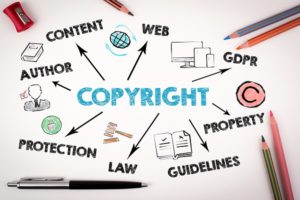Originally published in the Kitsap Peninsula Business Journal
The dust has settled over Instagram’s change in terms of services, which gave the photo-sharing site broader control over users’ content. Most people are more aware about the loss of control over their words or photos — their intellectual property — once they join free sites like Facebook, Twitter and LinkedIn. But what many people don’t think about often enough — and what can get entrepreneurs and others in hot water — is when and how they can use other people’s content.

Copyright laws are complex and best understood with the help of an attorney, but there are some common mistakes worth noting. Best way to summarize is by comparing other people’s intellectual work with real property: Unless you have explicit permission, you have no right to use it, even if you’re just “borrowing” it to post on your own blog, publish in your brochure, attach to your video or whatever.
Too often, business owners think they can just copy an image off someone else’s website and use it in their own materials. Even if that image is a logo of a company sponsoring your event, or a photo of a product you’re selling, you are violating that company’s copyrights unless you have its permission to use those images. (Logos are not always protected by copyrights but are protected on a much more limited basis by trademarks. But why take the risk?)
Same goes for words — you can’t simply lift a product or company description verbatim, for example, and include it on your site, in your report, etc. The law, of course, does allow for “fair use” in various circumstances (which doesn’t mean using the intellectual property without giving proper credit, by the way), but fair use is often not very black and white, so do your homework carefully.
On the other hand, ideas (among other things, such as facts and, strangely, recipes), are not copyrighted, only the way they are expressed. But unless it’s your original idea, best rule of thumb is to give attribution, even if you rewrite it in your own words.
Even when a photo or graphic is free, such as those offered on various websites, you have to read the fine print. They usually require a specific way to give credit (and if you can’t, you either have to pay or you cannot use that art). Don’t confuse “royalty- free” with “cost-free.” Royalty-free simply means you have a certain license to reproduce the images for your own benefit, not necessarily for free.
Same is true even for things like fonts. If you download a free font from a website repository, if there’s a text file attached to it, read it — often times they specify the font is for personal use only and cannot be used in any public-facing work.
Music is another frequently misunderstood IP. Owning a tune doesn’t give you the right to use it as a track for your video. And if you’re using music from one of those free-music websites, you better give credit. If you can’t, don’t use it. Period. (A word on personal videos: Once you post them to YouTube or another service for all your friends to see, you’ve just distributed it, and along with it, that cool Adele song you love. Don’t be surprised if YouTube takes that video down.)
Music is actually, by far, the most complex IP issue because of the numerous licenses governing every use. Suffice it to say, you are technically not even supposed to play your favorite CD in your shop for customers without a specific license or two.
Will the labels go after every mom-and-pop retailer violating the law? Will some company sue you for stealing their image off the web? Not likely unless you have deep pockets. But stranger things have happened. Even a “polite” cease and desist letter on an attorney’s letterhead is enough to ruin a perfectly fine Monday morning.
The same rules apply when someone’s work simply happens to be in a photo you’re publishing (even architecture is protected by copyright, not to mention that lovely painting that happens to be on the wall next to your subject).
One last common mistake: Just like that iTunes song you can’t use even if you own it, paying for something and having it in your possession doesn’t mean it’s free to use. You can’t use your favorite painting or purchased Mount Rainier photo as your ebook cover or blog illustration — you shouldn’t even share it on Facebook — no matter if you paid big dollars for it.
For business owners, this issue especially comes up when they commission something from a contractor or artist, whether it’s a newsletter design, portrait or article. Unless you have a contract that says this was “work for hire,” chances are the creator still owns the copyright to this work. Yes, you can freely use it for the purpose you commissioned it for, but beyond that, you’re in murky waters. Plus, the creator of the work can reuse that concept or work, whether for self-promotion or with a new client. So, again, the key word is homework.
By the way, also think about permission you need when you create your promotional goodies. For example, asking a person in a photo if you can use that for advertising is not just common courtesy. Using another person’s photo, likeness, etc. for your own gain is protected by law (another good reason you shouldn’t tag clients on Facebook without asking). This is a legal domain that has nothing to do with copyrights, but it’s a little extra food for thought next time you get ready to create that awesome promotional campaign, write that insightful blog post or film that fascinating how-to video.